Red and orange birds are quite common. Northern cardinals, summer tanagers, and many others – they’re all either fully or partly reddish!
There are even some red birds with black wings! The crimson-backed tanagers, scarlet tanagers, and vermilion flycatchers are only some!
But what about black birds with red wings? Where are they, and why haven’t we seen them flying around?
Keep reading, and you’ll find out! We’ve already done the hard work and discovered some species!
9 Black Birds with Red Wings
The truth is, there aren’t many black birds with red wings. And even those that people call black birds with red wings have only a very small patch of red on their wings.
If we compare this contrast to the one we can spot in red birds with black wings, the red is almost unnoticeable, at least in a static position!
Despite this, all the species listed below are proof of nature’s generosity! You’ll soon discover how remarkably beautiful they are!
1. Red-Winged Blackbird

- Scientific name: Agelaius phoeniceus
- Size: 17–24 cm (6.7–9.4 in)
- Weight: 41.5-64 g (1.46-2.3 oz)
- Wingspan: 31-40 cm (12-16 in)
There’s no list of black birds with red wings without the red-winged blackbird! Its name says it all!
These birds are widely known for their red shoulder patches, which are called epaulets. However, these red spots are characteristic only of males and are best seen when flying or engaging in courtship displays.
Alongside the red patch, there’s a yellow wing bar which only adds to their beauty. The rest of the plumage is purely black.
Females, however, have a completely different plumage, being blackish-brown rather than fully black. Nevertheless, some scientists argue that they also have some dark pink shades on their faces, while some captive females exhibit yellow spots on their shoulders. These colors can be associated with age and breeding/winter season.
If you thought these colors serve only to make these birds remarkable, we’ll tell you otherwise! If it weren’t for them, red-winged blackbirds wouldn’t be able to defend their territories. An experiment demonstrated this – 64% of the males whose wings were dyed black lost their territories.
The red-winged blackbird is native to North and Central America. The species is grouped into 20 to 24 subspecies according to their geographic distribution. Although they live in different places, the subspecies have a similar appearance.
Some populations are migratory, breeding in the north and wintering in southwestern North America. Other populations are year-long residents. Within their natural habitats, red-winged blackbirds forage for insects, seeds, berries, and small fruits.
2. Tricolored Blackbird

- Scientific name: Agelaius tricolor
- Size: 17.8-22.9 cm (7-9 in)
- Weight:56.7-85 g (2-3 oz)
- Wingspan: 26-33 cm (10.2-13 in)
As you’ve probably already guessed, the tricolored blackbird is a close relative of the red-winged blackbird.
However, compared to their sister species, the tricolored blackbird isn’t nearly as common. This small creature is found only in the coastal areas of the Pacific in North America, and its population is currently listed as Endangered on the IUCN Red List.
Nevertheless, despite being on the verge of extinction, they enjoy their lives together, living in breeding colonies of tens of thousands of birds! They’re considered a migratory species, flying south to Mexico when the temperatures drop and returning to California for the summer.
Like their relatives, male tricolored blackbirds exhibit distinctive red epaulets on their shoulders. However, unlike the red-winged blackbird, which has a yellow stripe underneath the epaulets, the tricolored blackbird’s feathers are white in the same spot. The whole body is glossy black.
Females are more brownish-black and feature gray strikes and white throats and chins. While they have the red spot on the shoulders, the white is lacking.
These creatures are omnivorous and feed primarily on insects (especially during the summer) like beetles, caterpillars, grasshoppers, and seeds (when the temperatures drop).
3. Red-breasted Meadowlark

- Scientific name: Leistes militaris
- Size: 19 cm (7.5 in)
- Weight: 40–48 g (1.4–1.7 oz)
Like the other two species we’ve described, the red-breasted meadowlark has red shoulder epaulets. But there’s a significant difference between the three species!
Besides the red shoulder epaulets, which are only visible in-flight, the red-breasted meadowlark has a bright red throat and belly. The rest of the feathers are black.
Needless to say, this plumage is valid only for males, as females are of a brownish color. This distinctive plumage prompted people to call this species the soldier bird and scientists to give it the specific name militaris.
Red-breasted meadowlarks inhabit northern South America and are considered residents of the area.
These vividly colored birds prefer living in moist grasslands and cultivated areas. During the breeding season, they build open cup nests on the ground.
When they go out foraging, red-breasted meadowlarks look for insects and seeds. They usually look for food on the ground.
4. Red-winged Starling
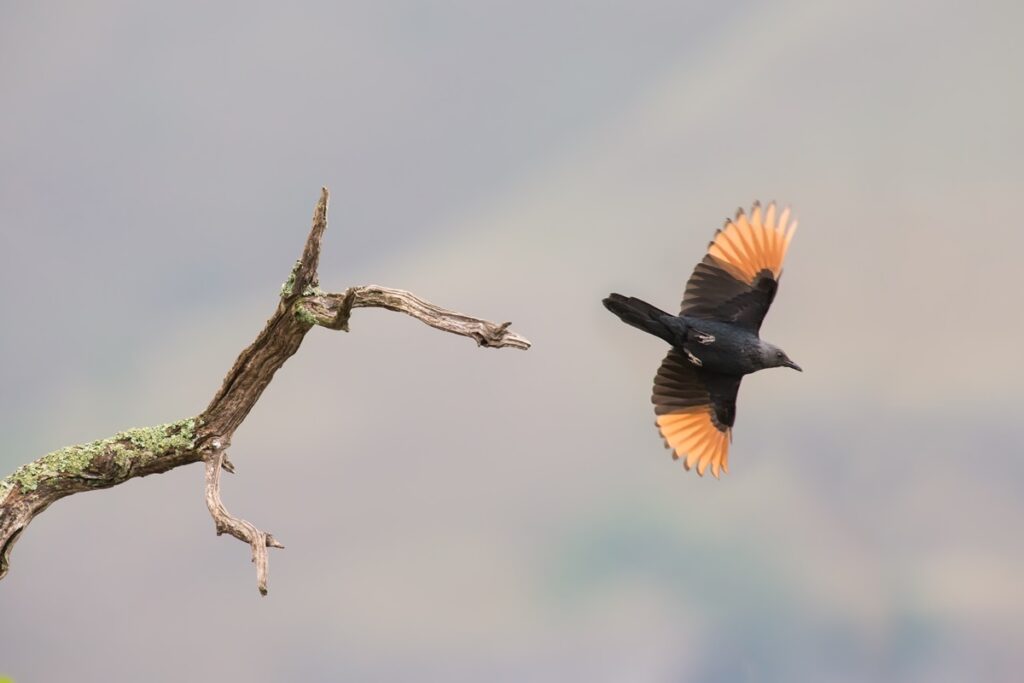
- Scientific name: Onychognathus morio
- Size: 27–30 cm (11–12 in)
- Weight: 115-155 g (4-5.5 oz)
The red-winged starling is a beautiful black bird! However, there’s so much more to it than its black plumage, especially if we’re discussing males, whose plumage is iridescent and features chestnut-reddish flight feathers, which make for an incredible sight in flight.
Females are slightly different, having ash-gray heads and breasts.
This species is widely distributed throughout eastern Africa and South Africa. More precisely, it can be found from Ethiopia to the Cape, being common in mountainous areas, especially during the breeding season.
On the other hand, they aren’t too picky and can establish themselves in various habitats, even cities. During the breeding season, red-winged starlings become quite aggressive and can attack those intruding on their territories.
These birds are omnivores. They feed on invertebrates, seeds, nectar, and berries.
5. Ross’s Turaco
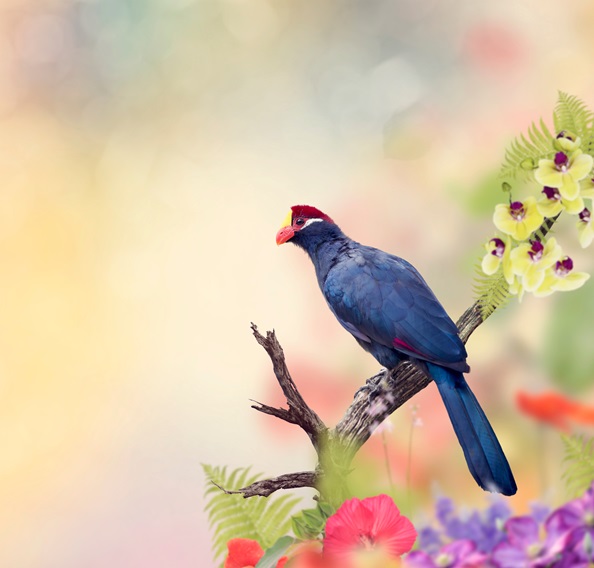
- Scientific name: Tauraco rossae
- Size: 38-45.7 cm (15-18 in)
- Weight: 454 g (1 lb)
Now’s that quite a sight – the unique Ross’s turaco! This bluish-purple bird is part of the Musophagidae family, whose members are known as loeries.
Unlike other species on our list, there’s little sexual dimorphism in Ross’s turaco individuals. All birds have a similar black-bluish body, a red head, and red flight feathers. The beaks are usually yellow, although those belonging to females might have greenish shades.
These birds are endemic to Africa, where they live in heavily forested areas. They do not migrate, not even short distances. During the breeding season, Ross’s turacos form monogamous pairs, and both parents participate in incubation and feeding.
They feed almost exclusively on fruits, flowers, and seeds. In fact, they have an important ecological role within their range, as specialists consider them an essential seed spreader species! If the opportunity arises, Ross’s turaco will also eat small insects.
6. Pesquet’s Parrot
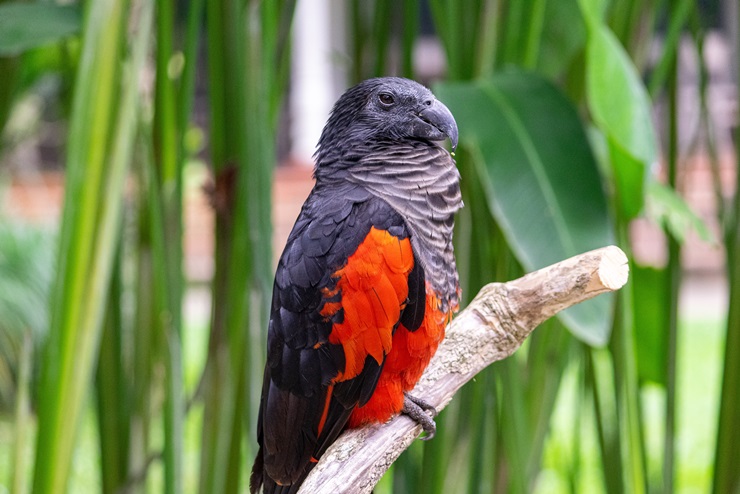
- Scientific name: Psittrichas fulgidus
- Size: 46 cm (18 in)
- Weight: 680–800 g (24–28 oz)
The Pesquet’s parrot is often called the vulturine parrot or the Dracula parrot due to their appearance.
These black birds have distinguishable grayish shades on their chests, red bellies, red wing panels, and red upper tail coverts. In short, the perfect black-and-red plumage combination! One thing that can help you distinguish males from females is the red spot behind the eye observed only in males.
These vulture-like parrots live only in New Guinea, inhabiting montane rainforests. They do not migrate and usually reside in pairs or in groups of around 20 parrots. During the breeding season, Pesquet’s parrots build their nests in large, hollow trees, where they lay two eggs.
They have a quite selective feeding behavior, as they’re known to prefer eating only some fig species. Occasionally, Pesquet’s parrots may delight in a flower or nectar meal.
Unfortunately, the IUCN Red List has assessed this species as Vulnerable, so we can only hope that conservation efforts will help stabilize the population numbers!
7. White-browed Meadowlark
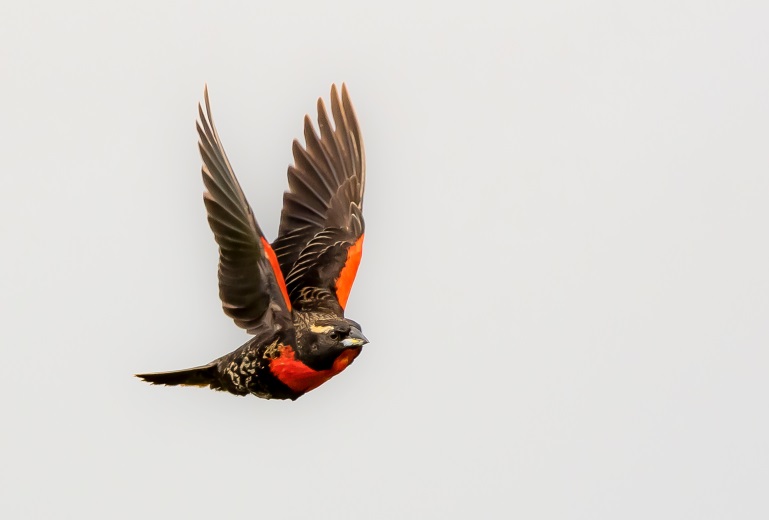
- Scientific name: Leistes superciliaris
- Size: 17-18 cm (6.7-7.1 in)
A close relative to the red-breasted meadowlark, the white-browed meadowlark is undoubtedly a remarkable bird species!
Males are primarily black with a bright red throat and belly. They also have bright red wing epaulets, like other species mentioned in this article.
Moreover, they have a distinctive white supercilium, a term used for the feathers arranged in a stripe running from the base of the beak above the eyes. Naturally, that’s where the species’ common name comes from!
Females are slightly different – they’re brown, have a pale throat, and exhibit a somewhat buffy eyebrow and breast.
These black-red birds live in South America. The populations that inhabit the southern part of the continent are migratory, although they do not travel long distances.
They prefer moist grasslands and pastures as habitats. While foraging, white-browed meadowlarks look for insects and seeds.
8. Red-shouldered Blackbird
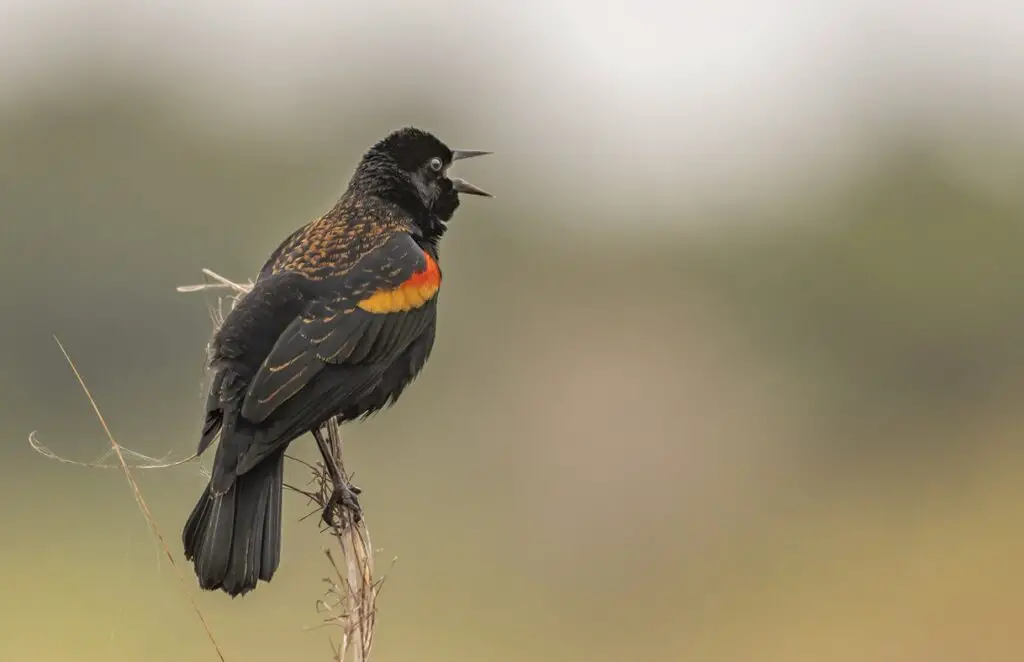
- Scientific name: Agelaius assimilis
- Size: 20-22 cm (7.9-8.7 in)
- Weight: 36-54 g (1.3-1.9 oz)
As much as we’d like to provide you with an extensive description of this species, the truth is, very little is known about them! What we do know, though, is that male birds have black plumage and feature bright red epaulets, while females have fully black plumage.
The juveniles resemble the females, as they’re almost completely black until they develop the male-specific red epaulets. However, juveniles also have a distinctive brown spot on their shoulders.
Red-shouldered blackbirds are endemic to Cuba, where they go by the name of Chirriador, which translates as creaker.
Unlike its red-winged relative, the red-shouldered blackbird is thought to be monogamous. These birds have established themselves in marshes, forests, and swamp lands. They build nests from plants and dry grasses.
9. Violet Turaco
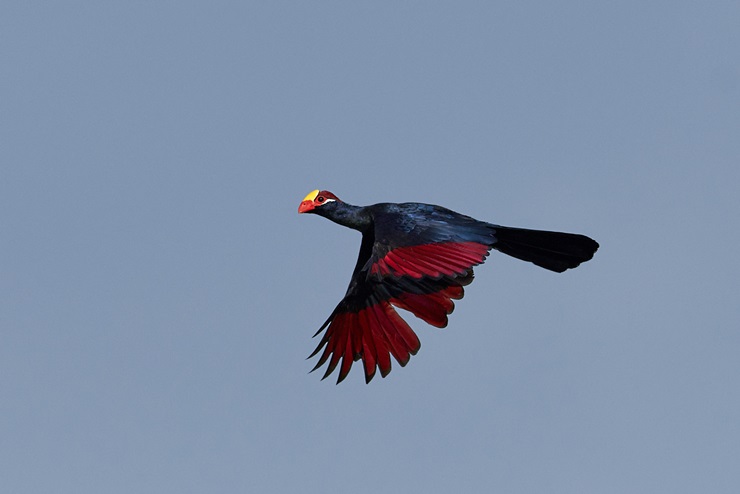
- Scientific name: Musophaga violacea
- Size: 48 cm (19 in)
- Weight: 360 g (12.7 oz)
- Wingspan: 21 cm (8.3 in)
Yet another turaco on our list! How can we miss them if they’re so beautiful?!
The violet turaco is a shy bird but with unmistakable plumage! It is predominantly shiny violet, except for the head, crown, and ear coverts. The forehead is bright yellow, the crown is chestnut, and the ear covers are white.
And let’s not forget the red parts on their wings, which beautifully contrast with the violet feathers! The bill is bright red as well.
Violet turacos inhabit West Africa and have established themselves in savannas, wetlands, and forests. They have quite a wide range, as their populations extend from Senegal through Nigeria.
Naturally, they are residents within their range. In fact, they prefer not to fly at all! Violet turacos are renowned for moving by running along branches and flying only if absolutely necessary.
During the breeding season, violet turacos engage in cooperative behavior, meaning that all birds care for the young, not only the parents.
They forage in groups as well, looking for leaves, flowers, insects, and fruits.
